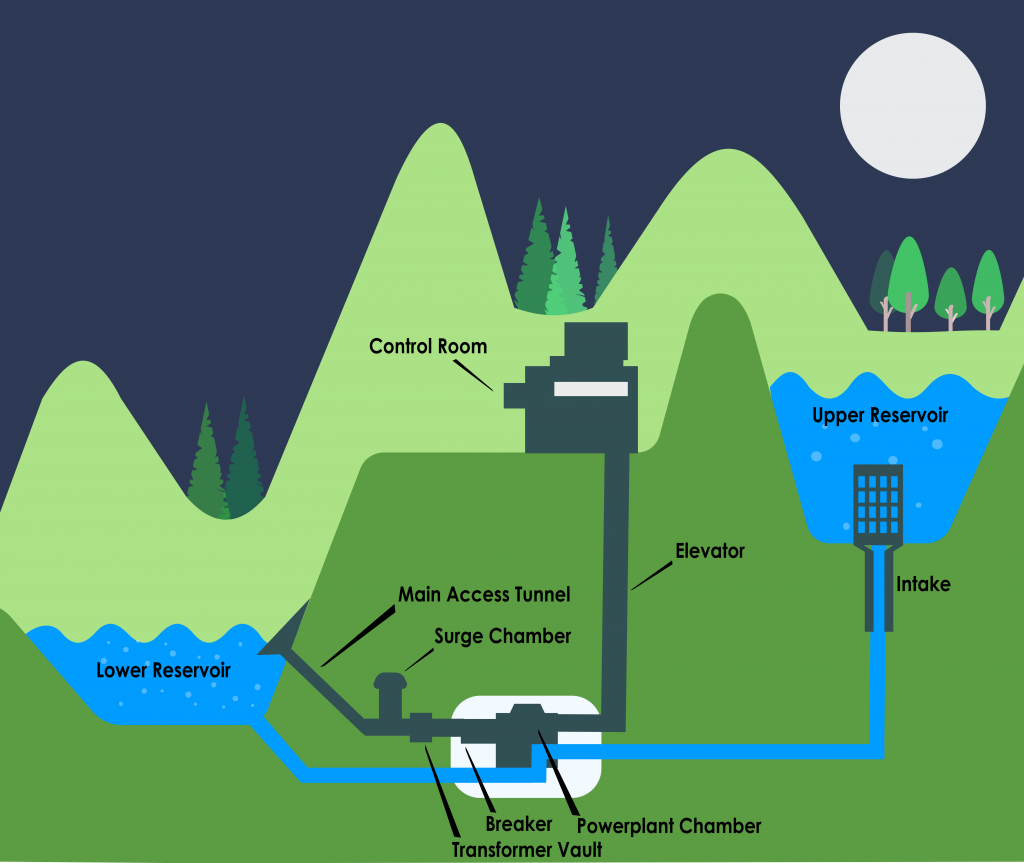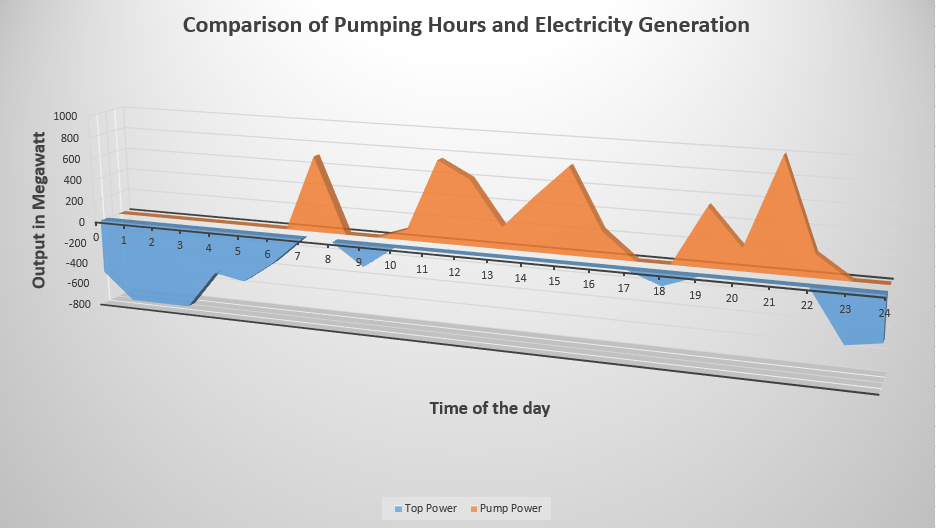The only form of energy storage presently, in wide commercial use, is pumped storage hydropower with their elevated reservoirs.
A major upside to storing potential energy in water in a reservoir is the spectrum of time horizons for which the energy can effectively be stored and conveniently be extracted; ranging from a few hours to several years.
Here, we’re going to discuss the technicalities behind the entire concept of hydropower with reservoirs for storing energy in a renewable form.
PSH is characterized by a long-life expectancy, normally between 50 and 100 years, round trip productivity of 70–85 percent, and a quick reaction time, generally within seconds or minutes. Pumping and generation can be carried out daily, or on a weekly or even seasonal cycle in large networks. PSH has site-specific and high capital costs as well as low operational and repair costs.
Principle and Purpose
The basic design of hydropower pumped storage plants includes two reservoirs – upper reservoir and lower reservoir. The elevation difference between these two water bodies is the basis of the entire operation. The potential energy of the water present in the upper reservoir is converted into mechanical and in-turn electrical energy through a turbine and generator.
Francis turbines are commonly used in such pumped storage hydropower plants. These turbines have a dual rotation feature! The same turbine can operate in both pumping and generation phases.
The generation phase is the conventional hydropower method where the water from the upper reservoir falls on the turbine to rotate it, hence, generating electrical energy.
During the pumping mode, the same turbine (in the case of a reversible pump-turbine) is used to pump water up from the lower reservoir to the upper reservoir. The idea is to repeat this loop repeatedly incorporating suitable conditions so that the efficiency and net profit of the plant can be maximized.
The main purpose of such pumped storage is to achieve the most efficient baseload generation by covering hours of peak demand and absorbing energy during periods of low demand. PSH plants are also famous for their exceptional production stabilization properties as well as their ancillary services.

Feasibility Study
Before starting such major projects, it is essential to run a feasibility study about the outcomes and deliverables of the project. These feasibility studies are further inspected by official government organizations, taking into consideration all spheres of society before applications of this sort are approved.
In case of approval for Pumped Storages, the inspection would majorly focus on the following fields of analysis.
Favorable Conditions for Pumped Storage
Under this category, the analysis will be made of the climate and weather conditions surrounding the proposed location. Besides that, geographical favorability will also be questioned. Alongside this, the effect of such a plant on the surrounding population as well as all other stakeholders must be considered.
The climate in the region must be mild, and preferably, humid. This helps in keeping the potential energy losses due to evaporation and absorption in check.
Naturally hilly or mountainous regions result in enormous cuttings in initial investments. Contrary to that, plain areas such as Germany are unsuitable for pumped storage hydropower plants.
Generating and Pumping Mode
PSH plants are modeled primarily to exploit the fluctuating rates of electricity in the region. These plants pump electricity from the lower reservoir to the upper reservoir and then the water from the upper reservoir falls to the lower reservoir through the turbine, generating electricity.
Although won’t the same energy be wasted in pumping water up the hill to the reservoir above which was converted from potential energy to electrical energy previously?
Despite this technically accurate question, the storage plant makes a profit through the innovative use of peak hours in the power generation industry. During hours of peak use, the rates of electricity consumption are high. In those instances, the pumped storage produces energy to bridge the production and consumption gap in the region.

Similarly, during low consumption hours such as during the night, pump storages utilize electricity bought at lower rates for pumping the water back to the upper reservoir. This is how profits are made using pumped storages all the while stabilizing the energy supply of the region by using these storages as backup plants.
During the feasibility study, this point evaluates the requirement of stability in power generation as well as exploitable peak hours in the region according to consumption requirements.
Overall Efficiency of the Plant
These plants play a vital role in stabilizing energy production rates in a region. PSH plants work as backup storage for primary power plants in the designated area.
However, like all other practical systems, some factors hinder plant operation in this process as well. These factors include evaporation, high temperatures, machine errors, absorption of water underground, etc.
Even so, on average the energy efficiency of the loop in a pumped-storage hydropower plant is between 70-80 %. While some sources claim an efficiency of up to 87%.
During the feasibility study, the efficiency of the plant is probably the most important feature to consider before approval.
Prospects of Future Research and Development
Today, the need for energy storage represents economic, environmental, geopolitical, and technical concerns. Growing global demand for alternatives to fossil fuels, resulting in price rises and political turmoil in several producing countries has made energy supply partly uncertain.
Energy storage is therefore a geostrategic asset and it is essential to reduce losses during overproduction, thus reducing overall energy consumption. Pumped hydro energy storage is the most widely used energy storage technology today but has prominent geological limitations.
Future obstacles for the production of PSH are linked to technological changes to maximize the possible head and stability in pump mode, as well as business models, grid connections, environmental and social concerns related to the growing demand for energy storage and balancing facilities, accompanied with even more sustainable and intermittent energy sources.